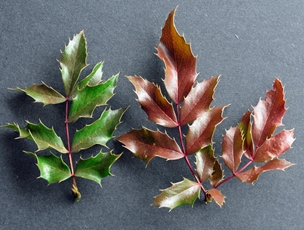Hit: No burn on this grapeholly

enlarge this imageIt's a shame to lose grapeholly (Mahonia aquifolium) foliage in the spring, when new growth is a luscious maroon, but it does happen where the plants are exposed to dry cold wind in the winter or late spring frosts catch the plant as it buds out. However, being nipped by the weather doesn't kill the plant. It does nix the bloom for that year, sometimes kills branch tips as well as leaves, and may stimulate even more suckering than usual, but new foliage emerges later.
There are no sure bets in dealing with living things...
...but every situation we face helps us learn more
possibilities, especially when we share with each other what we've
observed. So we're always glad to hear whether you used our
suggestions, and what happened next.
Last year I wrote to ask you if I could cover my Oregon
grape with leaves all winter to prevent frostbite. It's an infant
plant, only about 18 inches high, so it wasn't hard to do. And I'm
pleased to report that it worked perfectly. If I hadn't gotten a
bit ahead of myself and uncovered it just before the last extreme
cold snap of spring, it wouldn't have lost even one leaf. As it is,
the damage is limited. Finally the poor thing has an opportunity to
grow more in a year than it loses! - N.P. -
We're glad to have helped.
Oregon grapeholly (Mahonia aquifolium) is hardy to zone
5. In some winters in that cold, it may defoliate but will develop
replacement foliage. Because N.P. is growing the dwarf grapeholly
(M. a 'Compactum') which is only a few feet tall, it's possible to
cover a significant portion of its wood and leaves with an airy
mulch such as fallen leaves, or site it where snow will do that
job. There, the plant may do well even in zone 4.
Meanwhile, its big brother, the species Mahonia
aquifolium (more about it in What's
Coming Up 106), is an excellent, shade tolerant, evergreen
hedge 6 - 8 feet tall, but not a great candidate for covering.